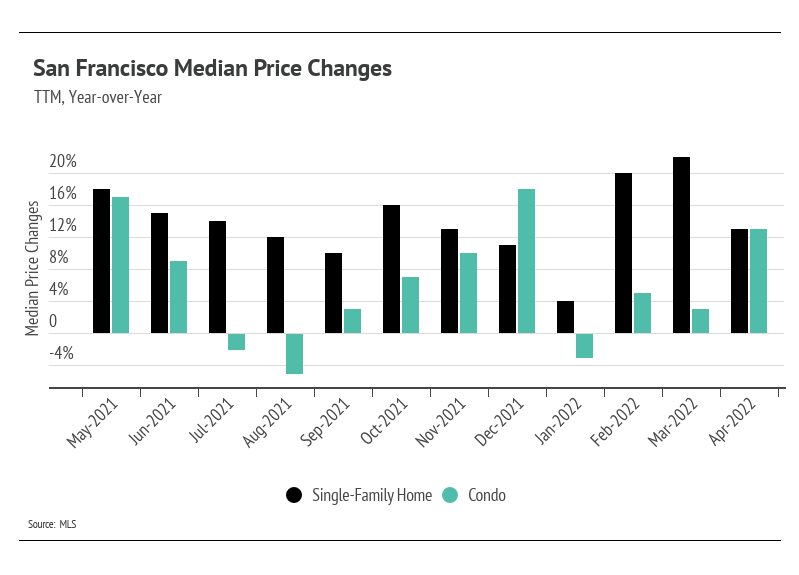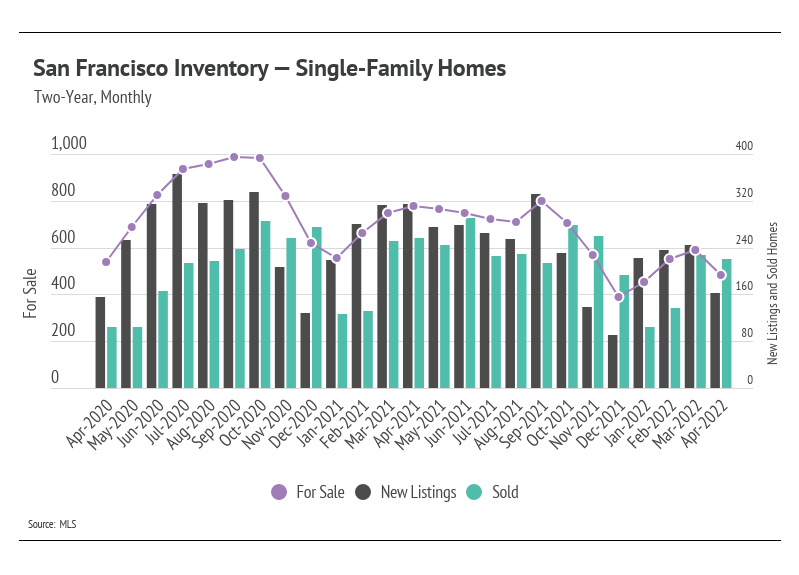SAN FRANCISCO REAL ESTATE MARKET UPDATE – June 2022
June 2, 2022
BUSINESS

June 2, 2022
BUSINESS

Quick Take:
Note: You can find the charts & graphs for the Big Story at the end of the following section.
_________________________
After the Fed’s May meeting, Fed Chair Jerome Powell announced that they are raising their benchmark rate by 0.50%, the largest hike since 2000. Earlier this year, the Fed was expected to raise interest rates by 0.25% at least six times this year, going from 0% to 1.90%. Now that each increase will most likely be 0.50%, the market expects the federal funds rate to reach 2.75% to 3.00% by the end of the year, which would be the highest in 15 years. Although the fed funds rate doesn’t directly affect mortgage rates, the rate hike moves into the broader economy quickly. Over the past four months, mortgage rates have moved about 2% higher for both 30- and 15-year fixed mortgages. Economists now estimate that 30-year mortgage rates could climb above 6% by mid-2022, which is fast approaching. Because the Fed indicated the path of rate hikes for the rest of the year, we expect mortgage rates to top out at around 7% this year for prime borrowers.
A rising rate environment increases short-term demand as buyers try to lock in lower mortgage rates, which is what we are seeing now. The increased short-term demand is driving prices right now outside of supply, which begs the question: Will higher mortgage rates actually drive down prices? No, they sure won’t.
In addition to rising rates, supply still drives home prices. In April, the housing supply ticked up ever so slightly, but it’s still 60% lower than the number of homes on the market in April 2020. We are entering what is traditionally the hottest time of year for the housing market with a record low supply of homes. Over the past four months, which had the lowest inventory on record, home prices increased 12%.
If you are considering buying a home, there aren’t many reasons to wait. Home prices and rates are still rising. The low supply continues to make the market extremely competitive. We are starting to see some softening in demand, but not nearly enough to balance the supply side of the market.





Quick Take:
Note: You can find the charts/graphs for the Local Lowdown at the end of this section.
Single-family home prices declined from the all-time high reached in March 2022, while condo prices reached a record high in April. It’s still too early, however, to determine how increasing rates will affect the market. Mortgage rate hikes only lower demand in the long term. In the short term, demand increases as buyers try to lock in lower rates. Over the past four months, the average 30-year mortgage rate has increased 2%, which means a 27% increase in monthly mortgage payments, yet prices keep moving higher.
The factors now affecting home prices are anticipated to have mixed results, unlike the past two years when all factors caused prices to increase. Rising interest rates, which will hopefully curb the rising 40-year-high inflation rate, will make homes less affordable and dampen demand over the rest of the year. They may, however, also lower supply as current homeowners reconsider their plans to sell.
Many homebuyers are also home sellers, moving from one home to another. Newer homebuyers and homeowners who refinanced over the past two years locked in one of the lowest rates in history, making moving a more difficult financial decision. This could keep supply unseasonably low with fewer new listings coming to market. In general, the Fed doesn’t have a tool to deal with supply-side issues: It uses monetary policy to affect demand, making money more or less expensive. As a result, the Fed’s rate hikes may result in unintentional effects on supply. In San Francisco, the lack of housing supply will keep prices rising in the coming months.
San Francisco’s housing inventory declined in April, which deviates from the seasonal norm and serves as an early indicator that home supply will remain depressed this year. The high demand and lack of new listings over the past year brought single-family home and condo supplies to record lows. Although the first quarter of 2022 had the lowest inventory on record, we were pleased to see that inventory increased, a trend that usually holds until mid-summer. With April inventory declining rather than rising, the next three months will help us forecast how inventory levels will trend for the rest of the year.
Even though inventory is low, sales remain incredibly high, especially when we account for the available supply. This trend once again highlights the high demand in the area. Sellers can expect multiple offers, and buyers should come with competitive offers.
Months of Supply Inventory (MSI) quantifies the supply/demand relationship by measuring how many months it would take for all current homes listed on the market to sell at the current rate of sales. The average MSI is three months in California, which indicates a balanced market. An MSI lower than three indicates that there are more buyers than sellers on the market (meaning it’s a sellers’ market), while a higher MSI indicates there are more sellers than buyers (meaning it’s a buyers’ market). Currently, single-family home and condo MSIs are low, indicating a strong sellers’ market.






_________________________
If you are interested in selling, buying, or just curious about the
San Francisco and Bay Area real estate market, please give me a call.
We are here to help you and anyone you care about.
_________________________
Stay up to date on the latest real estate trends.

HELM Newsletter
May 1, 2025

San Francisco Real Estate
April 1, 2025

San Francisco Real Estate
March 1, 2025

HELM Newsletter
February 1, 2025

San Francisco Real Estate
January 1, 2025

San Francisco Real Estate
December 1, 2024

San Francisco Real Estate
November 1, 2024

BUSINESS
October 1, 2024

BUSINESS
September 1, 2024
You’ve got questions and we can’t wait to answer them.